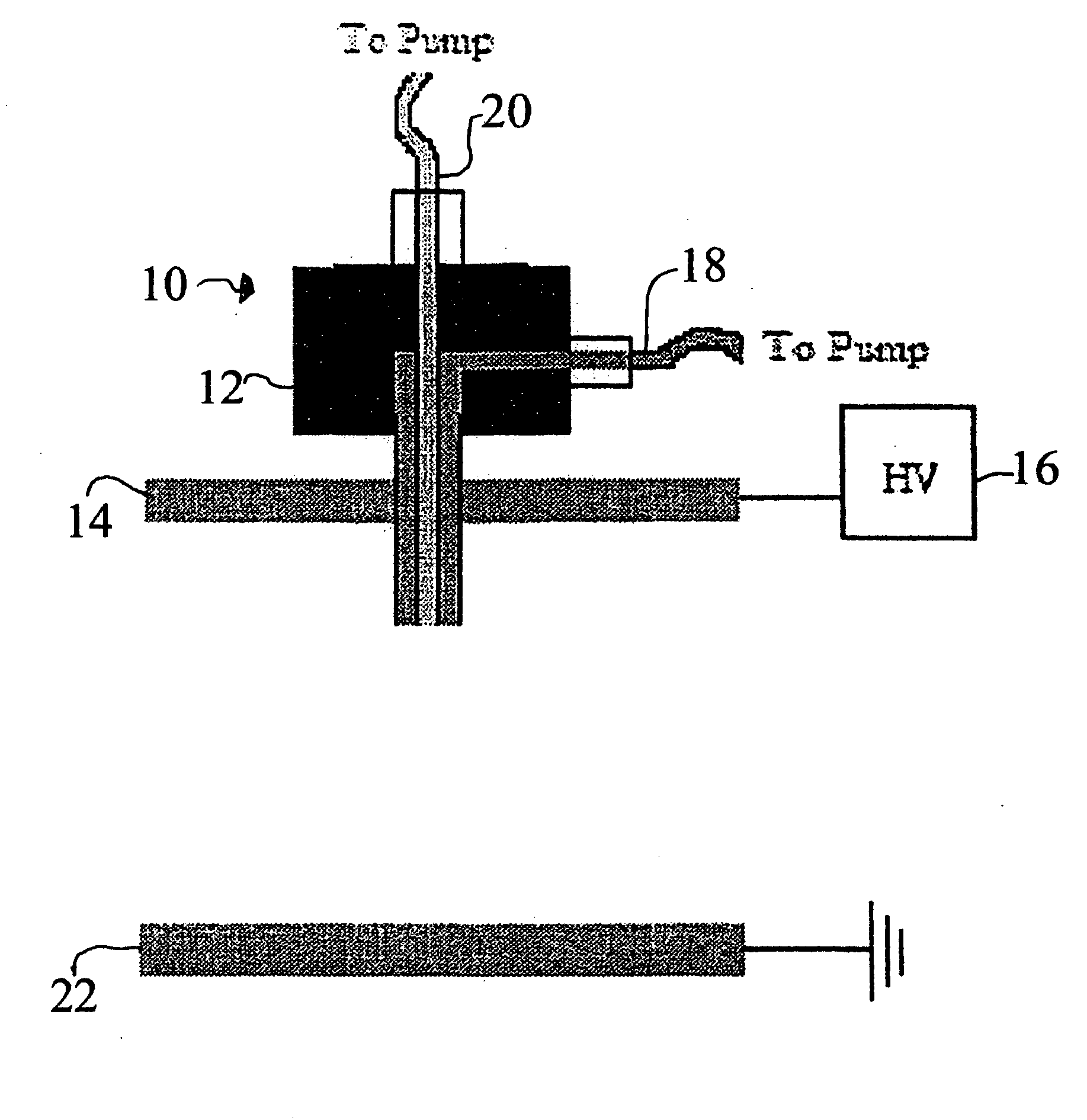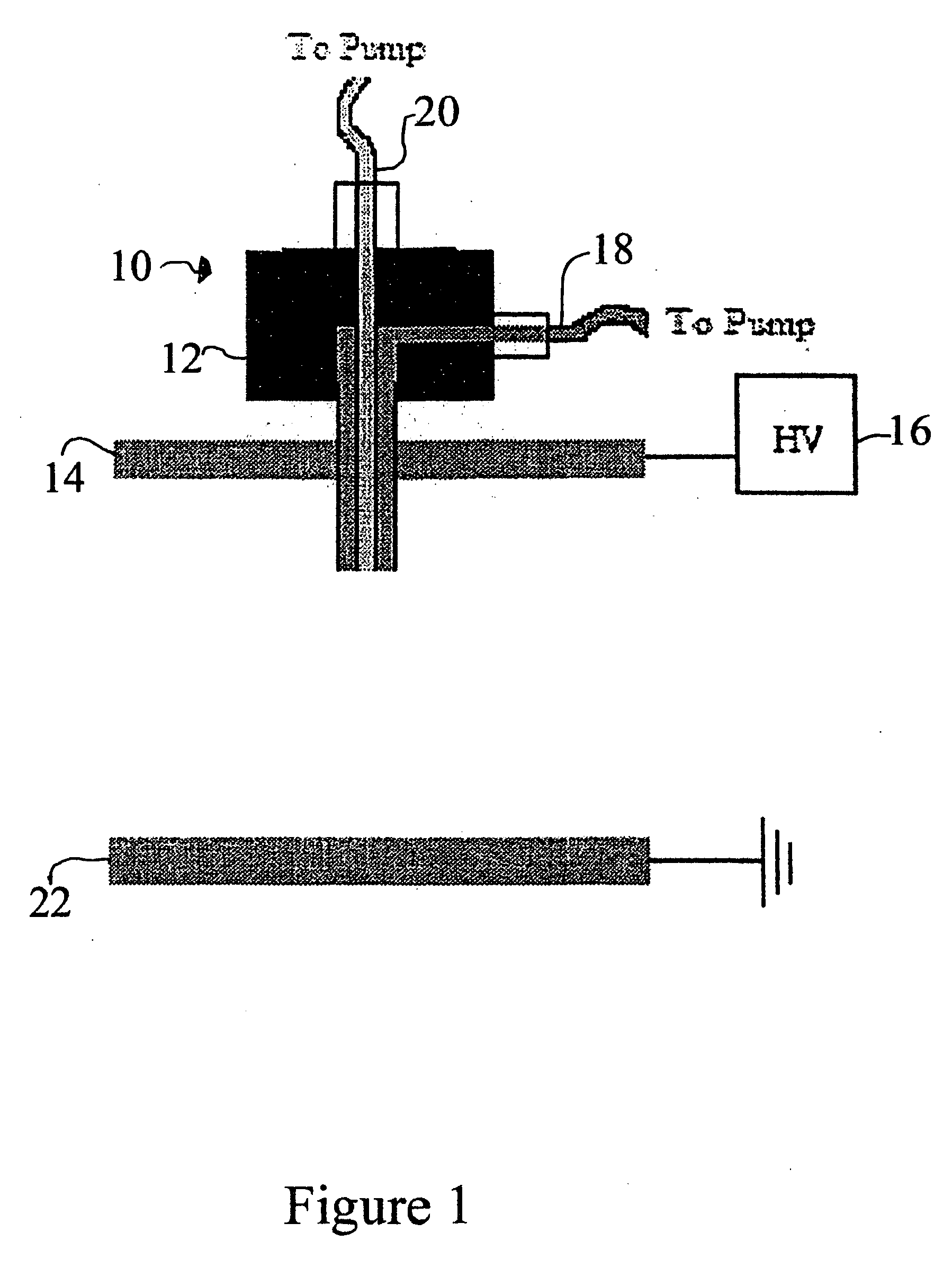Production of submicron diameter fibers by two-fluid electrospinning process
a two-fluid electrospinning and fiber technology, applied in separation processes, gravity filters, filtration separation, etc., can solve problems such as difficult processing
- Summary
- Abstract
- Description
- Claims
- Application Information
AI Technical Summary
Benefits of technology
Problems solved by technology
Method used
Image
Examples
example 1
[0035] A two-fluid electrospinneret as shown in FIG. 2 was used to prepare a nanofiber having a core of polyacrylonitrile (PAN), which is of particular interest as a precursor to carbon nanofibers. PAN (MW 150,000) was dissolved in N,N-dimethylformamide (DMF) to form an 8 wt % solution. The fluid used for the outer shell layer was 20 wt % polyacrylonitrile-co-polystyrene (PAN-co-PS) (MW 165,000) dissolved in N,N-dimethylformamide.
[0036] The two fluids were processed through the electrospinneret at a voltage of 26 kV and using a disk separation of 40 cm. The PAN had a flow rate of 0.008 ml / min. The PAN-co-PS had a flow rate of 0.07 ml / min.
[0037]FIG. 3A is an SEM image of the resultant core-shell fiber produced. FIGS. 3B and 3C are axial and lateral TEM views of the fiber.
[0038] Although the formation of PAN fibers with diameters of 50 nm have been reported in the literature, the overall size distribution in that case was bimodal, with average diameters around 100 nm and 200 nm. Th...
example 2
[0039] The procedure of Example 1 was repeated to produce additional PAN fibers at varying polymer concentrations. The concentrations and electrospinning conditions used were:
Systems123Voltage26 kV28 kV30 kVDisk40 cm40 cm35 cmSeparationCore-fluid8% wt5% wt3% wtPolyacrylonitrilePolyacrylonitrilePolyacrylonitrile(PAN)(PAN)(PAN)Mw 150,000Mw 150,000Mw 150,000in N,N-dimethyl-in N,N-dimethyl-in N,N-dimethyl-formamideformamideformamide(DMF)(DMF)(DMF)Flow rate0.008 ml / min0.008 ml / min0.002 ml / minShell-fluid20% wt25% wt28% wtPolyacrylonitrile-Polyacrylonitrile-Polyacrylonitrile-co-Polystyreneco-Polystyreneco-Polystyrene(PAN-co-PS)(PAN-co-PS)(PAN-co-PS)25% wt25% wt25% wtacrylonitrileacrylonitrileacrylonitrileMw 165,000Mw 165,000Mw 165,000in DMFin DMFin DMFFlow rate0.07 ml / min0.07 ml / min0.04 ml / min
[0040]FIG. 5A is the SEM image of an 8 wt % polyacrylonitrile (PAN) core fiber before removal of its polyacrylonitrile-co-polystyrene (PAN-co-PS) shell. The average fiber diameter was about 500 nm. ...
example 3
[0046] Nanofiber polyaniline (PAni) is of an interest for the formation of conducting nanowires, but is difficult to process in part due to low molecular weight and limited solubility in electrospinnable solutions.
[0047] Thus the procedure of Example 1 was repeated with a PAni / PVA—polyanilinesulfonic acid / polyvinyl alcohol—core / shell system. The electrospinning conditions and the fluids used were:
System4Voltage20 kVDisk25 cmSeparationCore-fluid5% wt Poly(anilinesulfonic acid)(PAni) in waterFlow rate0.005 ml / minShell-fluid8% wt Poly(vinyl alcohol) (PVA)Mw 146,000-86,000; in waterFlow rate0.01 ml / min
[0048] Examination of the resulting fibers showed that the PAni / PVA fibers had an average diameter of 310 nm. A lateral TEM image showed that the PAni core had a diameter of 120 nm. About a third of the fibers did not exhibit the core / shell structure. PAni is significantly more conductive than PVA, and it is believed that it has a higher volume charge density than PVA solution and thus ...
PUM
| Property | Measurement | Unit |
|---|---|---|
| core diameter | aaaaa | aaaaa |
| diameter | aaaaa | aaaaa |
| core diameter | aaaaa | aaaaa |
Abstract
Description
Claims
Application Information
 Login to View More
Login to View More - R&D
- Intellectual Property
- Life Sciences
- Materials
- Tech Scout
- Unparalleled Data Quality
- Higher Quality Content
- 60% Fewer Hallucinations
Browse by: Latest US Patents, China's latest patents, Technical Efficacy Thesaurus, Application Domain, Technology Topic, Popular Technical Reports.
© 2025 PatSnap. All rights reserved.Legal|Privacy policy|Modern Slavery Act Transparency Statement|Sitemap|About US| Contact US: help@patsnap.com



